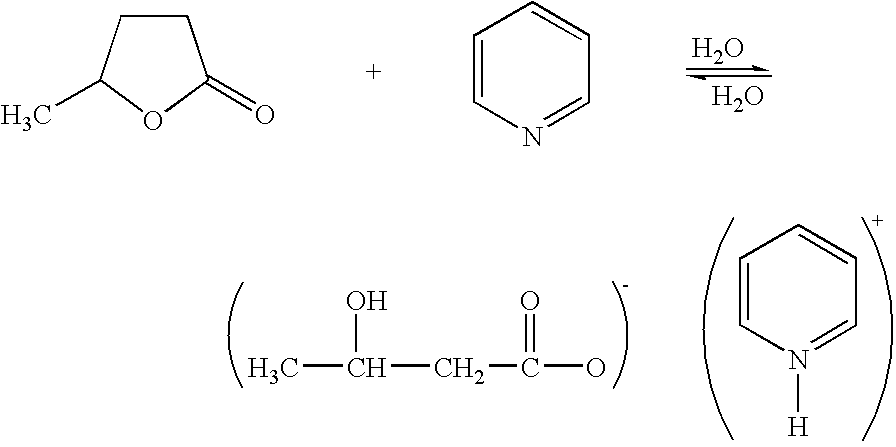Solvent-soluble block copolymide composition and process for producing the same
a technology of copolymer composition and solvent, which is applied in the direction of instruments, photomechanical equipment, optics, etc., can solve the problems of unobtainable electrical or other properties, unfavorable high-precision micro-processing, and white surface of the resulting film or molding,
- Summary
- Abstract
- Description
- Claims
- Application Information
AI Technical Summary
Problems solved by technology
Method used
Image
Examples
example 1-1
[0068] Four point four one (4.41) grams (15 mmoles) of 3,4,3′,4′-biphenyltetracarboxylic dianhydride (made by Ube Kosan Co., Ltd. with a molecular weight of 294.25; hereinafter BPDA for short), 12.32 grams (30 mmoles) of 2,2-bis(4-(4-aminophenoxy)phenyl]propane (made by Wakayama Seika Co., Ltd. with a molecular weight of 410.5; hereinafter BAPP for short), 0.15 gram (1.5 mmoles) of γ-valerolactone and 2.4 grams of (3 mmoles) of pyridine, both acting together as a catalyst, and 64.75 grams of a solvent anisole were provided as a starting feed.
[0069] First, the starting feed was stirred at 25° C. and 100 rpm for 0.5 hour in a nitrogen atmosphere into a homogeneous solution, which was in turn heated to 180° C. in an oil bath, where the solution was stirred at 180 rpm for a further one hour. During the resulting reaction, azeotropic water was removed.
[0070] After the completion of the first-stage reaction, the reaction product was cooled down to 25° C., and 8.83 grams (30 mmoles) of f...
example 1-2
[0072] Five point eight eight (5.88) grams (20 mmoles) of BPDA, 9.20 grams (10 mmoles) of siliconediamine (By16-853U made by Toray Dow Coning Co., Ltd. with an amine equivalent of 460), and 0.3 gram (3 mmoles) of γ-valerolactone and 0.47 gram of (6 mmoles) of pyridine, both acting together as a catalyst, 40 grams of a solvent anisole and 11 grams of N-methylpyrrolidone (NMP) were provided as a starting feed. First, the starting feed was stirred at 25° C. and 100 rpm for 0.5 hour in a nitrogen atmosphere into a homogeneous solution, which was in turn heated to 180° C. in an oil bath, where the solution was stirred at 180 rpm for a further one hour. During the resulting reaction, azeotropic water was removed.
[0073] After the completion of the first-stage reaction, the reaction product was cooled down to 25° C., and 2.48 grams (10 mmoles) of bicyclo[2,2,2]octa-2-ene-2,3,5,6-tetracarboxylic dianhydride (made by Aldrich Co., Ltd. with a molecular weight of 248.19; hereinafter BCD for sh...
example 1-3
[0075] Ten point five seven (10.57) grams (40 mmoles) of 5-(2,5-dioxotetrahydrofuryl)-3-methyl-3-cyclohexene-1,2-dicarboxylic anhydride (made by Tokyo Kasei Co., Ltd. with a molecular weight of 264.23; hereinafter CP acid for short), 8.65 grams (20 mmoles) of bis[4-(3-amino-phenoxy)phenyl]sulfone (made by Wakayama Seika Co., Ltd. with a molecular weight of 432.5; hereinafter m-BAPS for short), and 0.4 gram (4 mmoles) of γ-valerolactone and 0.63 gram of (8 mmoles) of pyridine, both acting together as a catalyst, and 20 grams of a solvent cyclohexanone were provided as a starting feed. First, the starting feed was stirred at 25° C. and 100 rpm for 0.5 hour in a nitrogen atmosphere into a homogeneous solution, which was in turn heated in an oil bath at 180° C., where the solution was stirred at 180 rpm for a further one hour. During the resulting reaction, azeotropic water was removed.
[0076] After the completion of the first-stage reaction, the reaction product was cooled down to room...
PUM
| Property | Measurement | Unit |
|---|---|---|
| Length | aaaaa | aaaaa |
| Length | aaaaa | aaaaa |
| Length | aaaaa | aaaaa |
Abstract
Description
Claims
Application Information
 Login to View More
Login to View More - R&D
- Intellectual Property
- Life Sciences
- Materials
- Tech Scout
- Unparalleled Data Quality
- Higher Quality Content
- 60% Fewer Hallucinations
Browse by: Latest US Patents, China's latest patents, Technical Efficacy Thesaurus, Application Domain, Technology Topic, Popular Technical Reports.
© 2025 PatSnap. All rights reserved.Legal|Privacy policy|Modern Slavery Act Transparency Statement|Sitemap|About US| Contact US: help@patsnap.com

